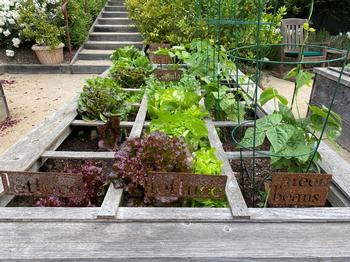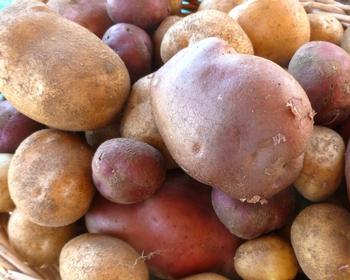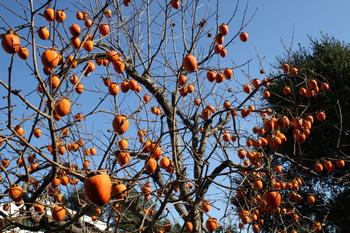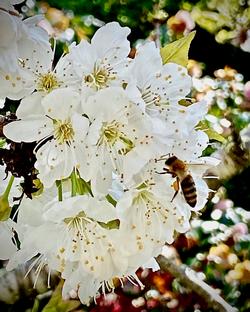Some like it hot: looking at predictions for global warming in your garden
-
Barbara Robertson
-
Shrinking ice caps. Growing deserts. The globe is getting warmer; climate zones are changing. Does that mean Marin gardeners should plant cacti now rather than apple trees?
“Between now and the 2050’s, for the most part we see the USDA hardiness zones shifting by only half a zone in California,” says Dr. Lauren E. Parker. “But, these zones are based on only the coldest temperature you’re going to hit. They don’t account for things like heat waves, is it wetter or drier. They’re just telling you if your plant is going to die over the winter.” Climate change calculators predict more heat wave days. Crops like lettuce that prefer temperatures under 78 degrees are vulnerable. Photo: Jill Fugar
Climate change calculators predict more heat wave days. Crops like lettuce that prefer temperatures under 78 degrees are vulnerable. Photo: Jill FugarParker is a postdoctoral fellow with the USDA California Climate Hub and John Muir Institute for the Environment at UC Davis, and acting coordinator for the USDA California Climate Hub. Her focus is on issues surrounding perennial agriculture in a changing climate.
“In Marin if we’re thinking 20 to 30 years in advance, we’re maybe not so concerned about shifting crop systems,” Parker says. “We’re more concerned about planting different varieties that would be tolerant to more variable and warmer conditions. Heat and drought tolerance will be increasingly important.”
Parker points to two science and research-based websites for climate change predictions: The Climate Toolbox (http://climatetoolbox.org) created by UC Merced, and Cal-Adapt (https://cal-adapt.org) developed by UC Berkeley’s Geospatial Innovation Facility. Potatoes, broccoli, cabbage, and spinach have an acceptable temperature growth range of 41 to 77 degrees F. Photo: Martha Proctor
Potatoes, broccoli, cabbage, and spinach have an acceptable temperature growth range of 41 to 77 degrees F. Photo: Martha ProctorWith these websites, gardeners can see predictions narrowed down to a home address: predicted minimum and maximum temperatures, heat wave days, chill hours, dry spells, first and last freeze days, and more.
Both sites use computer models based on “Representative Concentration Pathways” (RCPs), which encapsulate different possible future greenhouse gas and aerosol emissions scenarios to calculate probable future conditions. RCP 4.5 models a future in which there has been an attempt to reduce greenhouse gas emissions. RCP 8.5 is a “business as usual” scenario.
When I looked at Marin County on Climate Toolbox using RCP 4.5, I could see the predicted minimum temperatures for winter might increase by 2 degrees F in 2010 to 2039. With RCP 8.5, the increase is three degrees. Other seasons have similar increases.
The good news is that warmer temperatures could lead to more growing days during the year and less frost. Warmer temperatures increase evaporative demands, though, so there would be more water needs. Persimmons have a chill hour requirement of less than 100 hours. Photo: Marie Narlock
Persimmons have a chill hour requirement of less than 100 hours. Photo: Marie NarlockThe bad news is that fewer chill days affect apple, cherry, and pear trees, which want 1100 to 1500 hours under 45 degrees F. Climate Toolbox predicts the mean number of chill hours (32 to 45 degrees) for 2010 to 2039 in Marin might be as few as 516 using RCP 4.5. For stone fruit trees, a lack of winter chill results in delayed foliation, reduced fruit set, and poor fruit quality. Cherries are especially harmed by a warm November to February.
So, I might plant a persimmon tree (100 chill hours) rather than a cherry tree.
Parker notes the biggest challenges, though, will not be the increase in average background temperatures. It will be the increasing intensity, frequency, and duration of extreme events like heat waves, drought, and flooding.
The Cal-Adapt website predicts the probable number of Marin heat wave days (above 94.4 degrees F) will increase up to 13 in the future (years 2035 to 2064) given RCP 4.5. With high emissions, heat wave days could hit 16. That’s something to consider when choosing ornamentals. Fewer chill hours and a possible mismatch with pollinators could make cherry trees especially vulnerable to climate change. Photo: Barbara Robertson
Fewer chill hours and a possible mismatch with pollinators could make cherry trees especially vulnerable to climate change. Photo: Barbara RobertsonFor edibles, depending on a plant’s growing season, gardeners might consider planting and harvesting early to avoid late summer heat waves. The downside, though, is a possible phenology mismatch between when things bloom and when pollinators are ready for that.
“I’d be surprised if gardeners haven’t already noticed shifts in phenology,” Parker says. “Earlier ripening and harvest, earlier bloom times, and warmer summers causing crops to mature faster.
“A lot of these changes will play out in a slow process,” she adds. “One day you’ll wake up and say, ‘It just wasn’t like this 15 years ago.’”
For information on plants appropriate for earth-friendly Marin gardens, go to http://marinmg.ucanr.edu.




